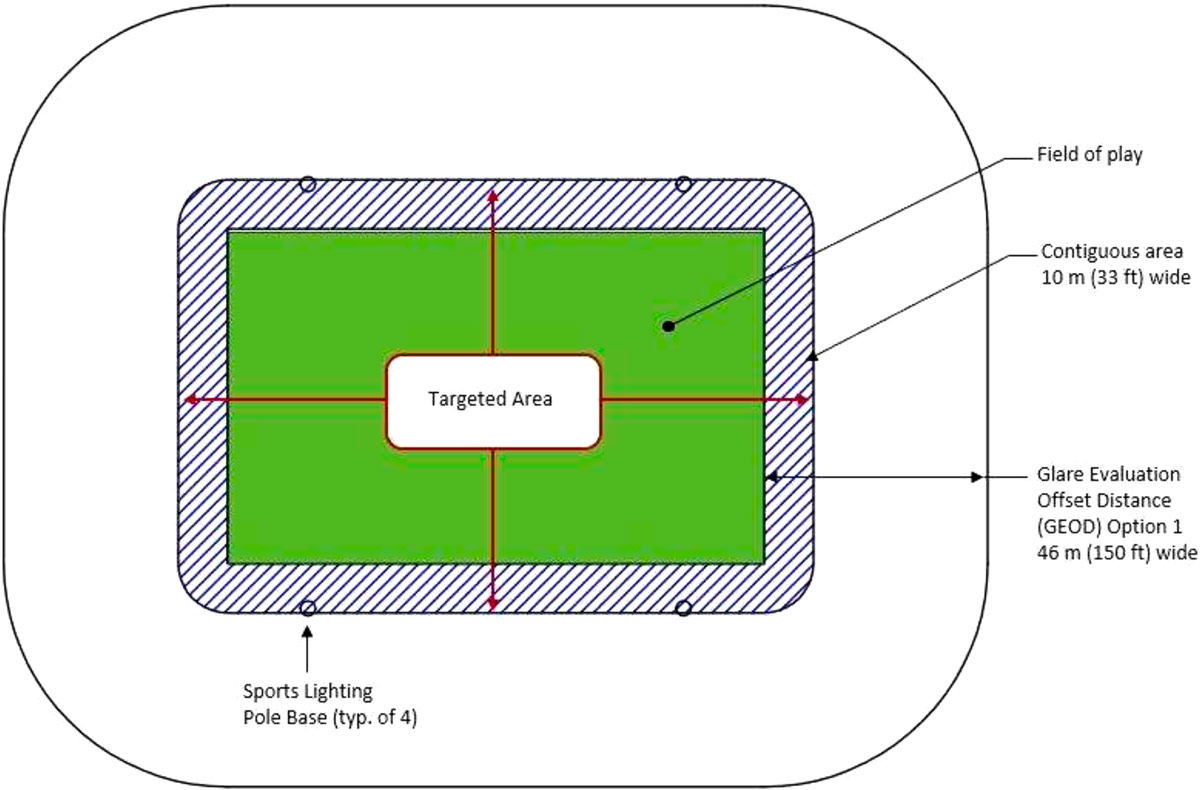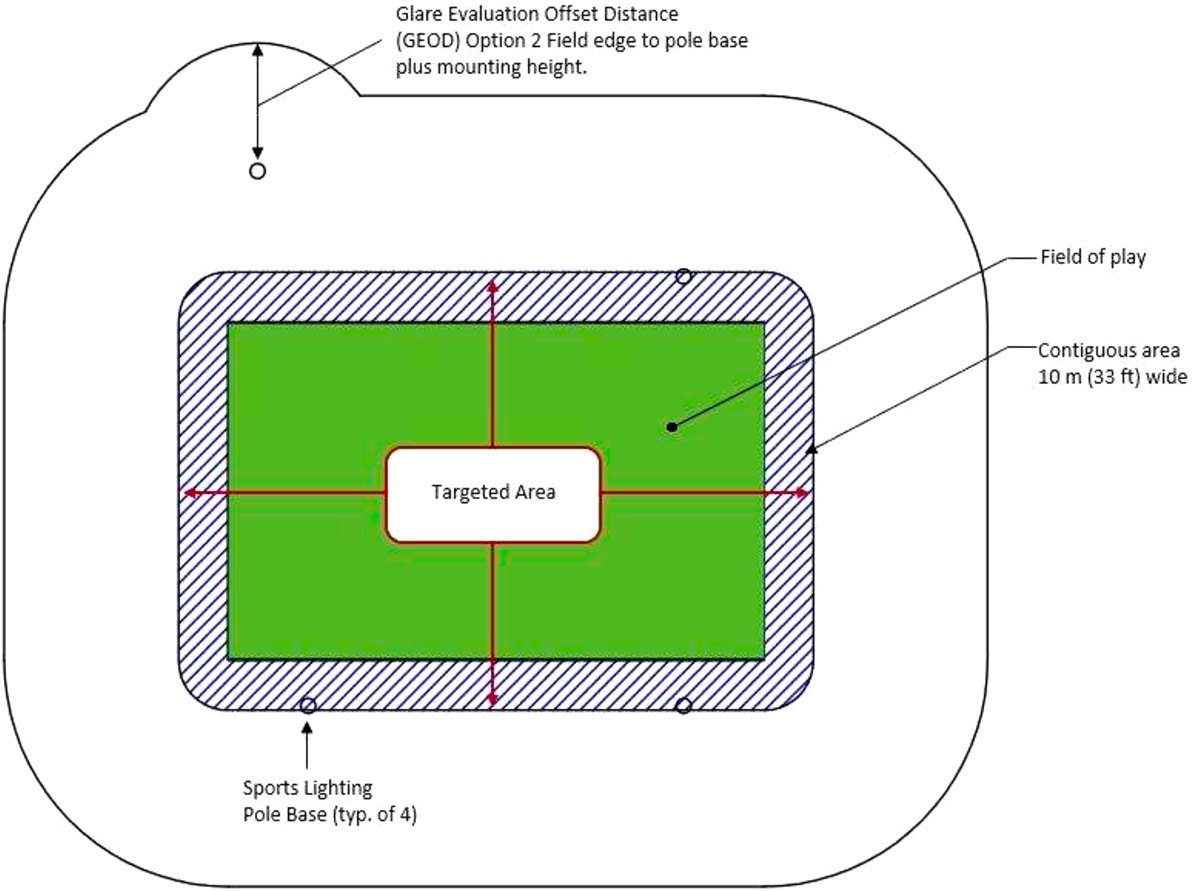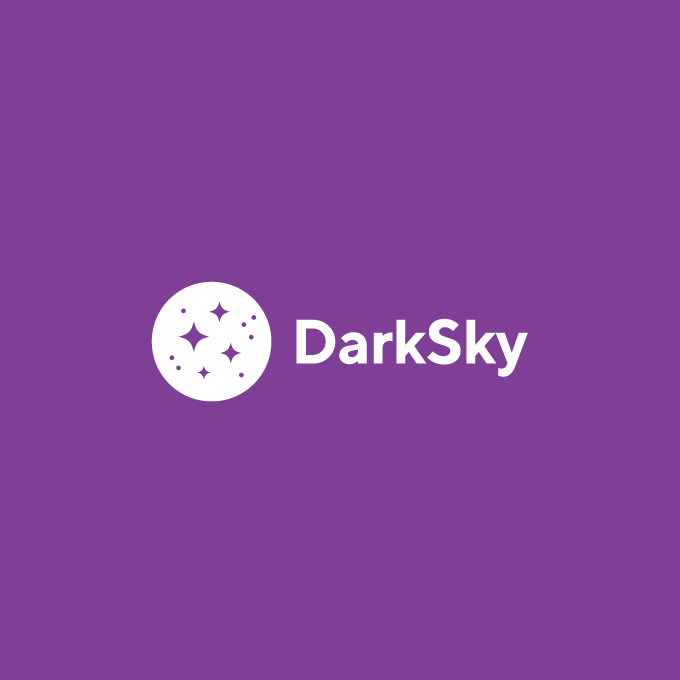
Outdoor Sports Lighting guidelines

Version 1.3, updated August 2023
1.0 General
1.1 Overview
A. Scope
This program provides DarkSky International certification for outdoor sports lighting (OSL) facilities, specifically the lighting of outdoor playing field surfaces illuminated by sports lighting equipment designed for that purpose. DarkSky certifications and awards are reserved for outdoor lighting that has been proven to significantly reduce light pollution relative to non-certified facilities of similar functionality.
B. Certifications
This certification is for lighting installations for the field(s) of play and includes analysis and measurements for the field(s) and immediate surround only. Multiple contiguous fields of play that share lighting equipment are considered one application for offsite and sky glow impacts, although illuminance levels must be differentiated for each field if the design criteria differ. Submittals for DarkSky OSL certification must demonstrate conformance with the DarkSky Lighting Criteria in Section 2. There are two phases of the certification process:
- Phase 1, DarkSky Design Compliance
An online project application must be submitted prior to construction (requires application fee, design documentation, and review by DarkSky International for conformance). Upon demonstrated compliance, DarkSky International issues a DarkSky Design letter of congratulations that can be used to demonstrate compliance for the benefit of the site owner or municipality to ensure that the design meets DarkSky OSL Criteria (see Section 3). - Phase 2, DarkSky Installation Certification
This is a field inspection performed by a representative of DarkSky International to verify that the installation meets the DarkSky Outdoor Sports Lighting Criteria. Upon successful field verification, DarkSky International issues a DarkSky Installation certificate.
1.2 Exclusions
A. Environmentally Sensitive Zones
DarkSky International does not certify sports lighting facilities located in areas especially sensitive to lighting, such as CIE Environmental Zones E0 and El, or IDA/IES Lighting Zone LZ0.
1.3 References and Standards
A. Local Codes
The project must be in compliance with all applicable local codes and standards (e.g., state, province, county, or municipal lighting ordinances, building and electrical codes, energy codes, and product labeling such as by Underwriters Laboratories or equivalent).
B. Lighting Standards
The basis for on-field illuminance values shall be the latest version of ANSI/IES RP-6, Recommended Practice: Lighting Sports and Recreational Areas, unless the owner, location and/or authority having jurisdiction mandates compliance with a different lighting standard. If a different standard is required, the applicant shall submit the name of the standard in the application along with the prescribed design criteria values for the application(s).
1.4 Definitions
A. aerial sports
For the purpose of this program, aerial sports are those in which the height of a ball in play would, in the normal course of playing the sport, exceed the height of the sports lighting poles. This category is limited to baseball, softball, cricket, and American football (fly balls and kick-offs are examples of plays with high-flying balls). In these cases, some uplight is required for ball visibility (see Section 2.2).
B. class of play
This is determined by standards development organizations and, in combination with the specified sport being played, is a determinant for light level recommendations. Applicants must provide the class of play for each playing field included in the application to determine the appropriate illuminance level.
C. control zone
A group of light fixtures that are controlled together, i.e., switched and/or dimmed together.
D. field of play, playing field
For the purposes of this document: the field, court, pool, or other area where the relevant sport is played.
E. glare evaluation offset distance (GEOD)
The distance between the edge of the playing field and the point at which the glare criteria will be evaluated through computer calculations in Phase 1 and field measurements in Phase 2. This GEOD is the perpendicular distance extending outward from the edge of the playing field equal to whichever of these values is greater:
- 46 meters (150 feet); refer to Figure 1-1
- The sum of the distance from the playing field to the sports lighting pole base plus the pole height; refer to Figure 1-2
If access to the GEOD is not possible due to obstructions such as buildings or landscaping, the field measurements shall be evaluated from representative locations as practicable.

Figure 1-1 — Example of glare evaluation offset distance and targeted area.

Figure 1-2 — Example of glare evaluation offset distance and targeted area.
F. targeted area
The region defined as the playing field(s) plus the contiguous area extending 10 meters (33 feet) beyond the playing field perimeter. (See Figures 1-1 and 1-2.)
2.0 Lighting Criteria
2.1 Uplight
A. Sports Field Lighting
- Criterion
No luminaire, as positioned and aimed in its final installed position, is allowed to emit light above horizontal. Note: Having a luminous intensity of zero candelas emitted at or above the horizon when a luminaire is aimed directly downward, as shown in a photometric report, is not sufficient for compliance if the luminaire is tilted (i.e., aimed above nadir) in its installed position.- Exception for Aerial Sports
For aerial sports as defined in this document (see Section 1.4.A), the total lumens emitted above horizontal shall not exceed 8% of the total lumens delivered, as calculated for the sum of all luminaires used in the sports lighting system (see item 2.b, below). For example, if in their installed positions the luminaires emit a total of 10,000 lumens downward, then no more than 800 lumens may be emitted above horizontal.- Any uplight used for this purpose shall be designed specifically for the purpose of illuminating a ball in flight within the field of play, and shall be controlled separately from the lighting aimed downward to illuminate the field of play.
- For fields that have multiple kinds of sports, the uplight component used for aerial sports must be inactivated or turned off for non-aerial sports.
- The control of uplighting shall be included in the controls documentation described in Section 2.5.
- Exception for Aerial Sports
- Calculation
- Non-aerial Sports Fields
Calculations shall include the sum of the total lumens generated by all of the luminaires aimed at the field of play, as emitted in their final aimed position, for 1) lumens emitted above horizontal, and 2) lumens emitted below horizontal. Note: The total lumens emitted above horizontal in this calculation must be zero to comply with the criteria. - Aerial Sports Fields
Calculations shall include the non-aerial sports calculation, as well as the calculated sum of the total lumens generated by all of the uplighting luminaires allowed for aerial sports. The calculation shall provide the ratio of the total uplight lumens to the total emitted lumens (uplight + downlight).
- Non-aerial Sports Fields
2.2 Targeted Lighting
A. Sports Field Lighting
- Criterion
At least 85% of the total lumens generated by the downward-aimed sports lighting luminaires illuminating the field of play must fall inside the targeted area (refer to Section 1.4.F). - Calculations
The calculation shall include the total number of lumens falling within this zone (x), the total lumens generated below horizontal as calculated in Section 2.1.A.2 (y), and the percentage (x/y) x 100.
2.3 Glare
A. The maximum allowable luminous intensity from any luminaire lighting a sports field is 1,000 candelas as measured for each field of play at the glare evaluation offset distance (GEOD; see Section 1.4.E). Calculations and measurements at this GEOD perimeter shall be at 1.5 meters (5 feet) above finished grade, and the calculation and measurement points shall be spaced 3 meters (10 feet) apart around the entire perimeter.
B. The luminous intensity calculation shall be verified during Phase 1 through the computer calculation report and during Phase 2 through field measurements.
2.4 Illuminance values
A. Sports Field Lighting
- Criterion
The average illuminance on each field of play shall be no more than 10% above the average target illuminance levels defined by the relevant standard (see Section 1.3.B), based on the sport and the class of play. - Calculations
The lighting calculations must be performed on DarkSky International approved software and show compliance via a plan view and illuminance grid, with the calculated average, minimum, and/or maximum illuminances at the height recommended for the sport (as defined in the standard). The point spacing in the illuminance grid shall be as specified in the standard, or no more than 3 m (10 ft) apart if the spacing is not specified in the standard. The lighting calculations must be performed with all luminaires emitting 100% of their light output, except for applied light loss factors. Note: If the lighting calculations for the playing field are for maintained illuminance values based on a light loss greater than 10%, the control system must be programmed to dim the luminaires to meet DarkSky certification requirements (average illuminance on the field of play to be no higher than 10% over that defined by the standard) for each initial preset in each playing field configuration. The dimmed control criteria must be called out in the control schedule documentation (see Section 2.5).
2.5 Controls
A. Automatic Controls
Automatic control systems with remote control capability via smartphone apps or direct remote communication to the company or facility responsible for handling the lighting controls are required to enforce shut-off at the locally established curfew time, but not later than 11:00 p.m. (2300 hours).
B. Manual Controls
The automatic control system may include onsite manual and/or remote control capability to allow for the lights to be turned on or off at will (between dusk and curfew) to ensure that only active sports fields are lighted. Manual controls shall be accessible to authorized personnel only.
C. Dimming Controls
The control system shall include automatic and manual dimming capability to implement uniform and variable illumination levels, to adapt for different task lighting needs on the field, such as for class of play, competition athletics, band practice, striping, mowing, and sports practice. Dimming for the different uses shall be programmed as presets for each of the uses. Dimming shall be possible across the range of 25% to 100% of full illumination.
D. Separate Control Zones
Lighting control zones (see Section 1.4.C) are required to separate fields of play into different zones and to separate the down lighting and uplighting for each field into different zones. The lighting for other areas such as concessions stands and parking lots shall be zoned independently of the playing field lighting; however, they must still follow all other controls criteria contained in Section 2.5.
E. Control Policy Documentation
A formal lighting policy must be included in the Phase 1 application. The policy shall include the planned types of activities for each playing field, the illuminance levels for each of those activities, and the curfew time for each of those activities. All listed conditions in the schedule must be demonstrated during the Phase 2 inspection.
2.6 Spectrum
A. Sports Field Lighting
- Maximum CCT
The maximum allowable correlated color temperature (CCT) of light sources illuminating the field of play is 5700 K. - Preferred CCT
The primary visual considerations for sports lighting are the critical visual needs for player safety and playability, class of play, and preferential color rendering for the viewing audience. For these reasons, DarkSky certification for sports lighting emphasizes strict compliance with the OSL uplight, targeted lighting, glare, and controls criteria to minimize light pollution. Lower CCTs than the maximum allowed are encouraged if practicable.
3.0 Phase 1 — DarkSky Design Compliance
3.1 Application, Submission, and Fees
A. Applicants must apply for the program and upload lighting calculations and supplemental information through the online application.
B. Submissions must include the following:
- Applicant Form
Applicants must provide general information about the project as well as contact information for the lighting designer or engineer and the owner or operator of the project. For each field of play, the following must be listed:- Type of sport and class of play
- Target illuminance level and other criteria, based on the standard used (Note: If any standard other than the latest version of ANSI/I ES RP-6 is used, provide the name of the standard)
- Curfew time
- Submission Fees
Fees cover the initial application and two resubmissions. If more than two resubmissions are required, the applicable fees will be required for each subsequent resubmission. - DarkSky Sports Field Design Review Fees
- For up to four contiguous sports fields in a single submission, the fee is $1,000 U.S.
- For each additional sports field, the fee is $200 U.S.
- Terms
Fees must be received by DarkSky International before the analysis will be performed.
3.2 Project Review for Compliance
A. Design Evaluation
DarkSky International will evaluate materials sent by applicants for conformance with the DarkSky Lighting Criteria (see Section 2) and provide applicants with feedback.
B. Conformance
If the project design conforms with the DarkSky Lighting Criteria, DarkSky International will inform the submitter and provide a letter of congratulations to the applicant. The project will also then be filed at DarkSky International as an OSL-Compliant Design and be put in the queue for the Phase 2 Installation Certification process.
C. Nonconformance
If the project does not conform with the DarkSky OSL Criteria, DarkSky International will inform the applicant. They will have the opportunity to change the design to meet the lighting criteria and resubmit their design (see paragraph 3.1.B.2 Submission Fees).
4.0 Phase 2 — DarkSky Installation Certification
4.1 Inspection Coordination and Fees
A. Scheduling the Inspection
Upon completion of the project, DarkSky International must be contacted to coordinate a date and time for the field evaluation. The Owner’s representative must be present for the inspection to provide full access to the site, and time must be allowed for all measurements required to demonstrate conformance with the DarkSky OSL Criteria. The system must be fully operational, with all controls fully working, to test each control zone and light level at night for conformance with the control schedule approved in Phase 1.
B. Inspection Fees
- DarkSky Sports Field Installation
- Fees are found here.
- Terms
- Fees are due upon agreement of a meeting date and time, to confirm the field inspection booking date. This fee is non-refundable.
- Remaining fees for flight, hotel, and per diem meal rates are due prior to the appointment date; receipts will be provided for all expenses along with an invoice.
- Applicants are responsible for informing DarkSky International of the potential for inclement weather that may hamper the ability to take the lighting measurements required. In such cases, rescheduling may be required. Additional costs due to scheduling are the responsibility of the applicant.
C. DarkSky International will provide the following deliverables:
- Field measurements at the project site
- A written report of findings, including points of failure if the facility is nonconforming
- An estimate of costs for re-evaluation by DarkSky International if initial site visit measurements do not pass certification requirements
4.2 Certification
A. DarkSky installation certifications are given only after the field inspection has demonstrated full compliance with the lighting criteria described in this document (see Section 2).
B. DarkSky certifications allow the owner of the facility to place a DarkSky International-provided placard on their facility notifying the public of the DarkSky Compliant certification.
C. DarkSky International promotes all certified facilities on the DarkSky.org website, recognizing the name of the field and the owner or municipality that operates the facility.
APPENDIX A
Background
The following background is provided for the reader to better understand the rationale within this document.
Sports lighting applications have a high potential for light pollution due to the brighter than normal lighting equipment required for playing sports. Sports lighting luminaires are often cited as nuisance lighting, as they can be excessively glaring and can be seen from great distances away from the playing field.
Changing sports lighting from metal halide lamps to LED lighting systems provides an opportunity to improve sports lighting and reduce light pollution, because the beam of light and the light levels provided by LEDs can be more precisely controlled. By using improved optical controls to limit the light to the area of play, proper shielding to minimize offsite glare, dimming controls, and timing controls, the effectiveness of lighting a sports field is increased while energy use and light pollution are decreased.
This theory was put to test at a proposed sporting complex in Sahuarita, Arizona, United States, at a site that was near the Whipple Observatory on Mt. Hopkins in Southern Arizona. In this case, the lighting design team met with the observatory personnel and city leaders to discuss whether it might be possible to light a sporting complex without compromising the needs of astronomers and others for dark, unpolluted skies, and without providing light levels or glare that would annoy neighbors. The goals of the project were focused on the need for minimizing light pollution, glare, and light trespass while also allowing for recreational activities during nighttime hours. A solution was put in place that satisfied everyone. The results are shown below. After the installation was completed, a group of DarkSky advocates including members of the DarkSky Technical Committee gathered at the site and took measurements that could then be used to establish criteria for future installations. The DarkSky Approved Outdoor Sports Lighting Program criteria were therefore established from a proven installation that meets DarkSky objectives, and has proven to meet astronomical observers’ needs as well. This project proved that lighted sporting venues and dark sky initiatives can coexist.
Contact
To learn more, contact the DarkSky Lighting Program Manager.
Download the guidelines
Outdoor-Sports-Lighting-Guidelines-v1.3-08-28-2023.pdf (PDF)
Apply
If you’re ready to apply, make sure you’ve reviewed the guidelines above, then fill out the form.
Phase 1 payment is due upon form submission.

















